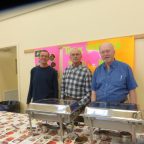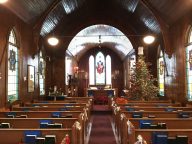Trinity as Hospitality (May 27, 2018)
An experienced preacher was asked, “What one piece of advice would you give to young preachers?” He said, “Every time you preach, always ask why others should believe what you’re saying.”
I call it the “So What Test.” It’s good advice. Why should you believe what I say up here? How does this sermon point to life for us all? Is it true? Is it worth saying? What difference does it make? So what?
That advice is particularly apt today. It’s Trinity Sunday. We are encouraged on this day to explore the Christian doctrine of Three–in–One.
Honestly, for me this Sunday is about the most difficult Sunday on which to preach. I don’t think about the Trinity much. In fact, I think about it maybe … one day a year.
Even though we don’t think about Trinity much, we are surrounded by language about the Trinity in worship every week. We treat it almost as a formula: “the grace of Christ, the love of God, the fellowship of the Holy Spirit be with you.” Or we sing the Creed, which is built around the Trinity: “I believe in God … I believe in Jesus Christ … I believe in the Holy Spirit…”. Every Eucharistic prayer mentions the Trinity. All that we do in worship is filled with trinitarian language and understanding.
It’s just there … kinda like wallpaper. We hardly notice it … except for today.
You won’t find the word in the Bible, although there are several passage which mention Father, Son, Holy Spirit. So if it’s not biblical, where does it come from?
It was developed in the 4th century, as a response to a series of controversies. This doctrine was born in conflict. In the early centuries, the church was trying to figure out the right way to believe. There were many such controversies and fights in the early church.
In the case of this doctrine, it was developed as the result of a debate about how God, Jesus, and the Spirit are related to each other. God was divine. But what about Jesus? Was he really the Son of God? On the other hand, was Jesus really human, or did he only appear to be human? And if Jesus is God, is he equal with God or just a little bit less than God? And where does the Holy Spirit fit into all this?
As one scholar puts it, “this doctrine developed not out of a desire to understand God, but rather as part of a vendetta against heresies.”
And while that might be important for theologians and philosophers to wrestle with, it doesn’t feed my spiritual life much. I live my life with these convictions:
- God is a God of justice and unbreakable love;
- we can know God in many different ways, so we stay open to each other and to different traditions;
- the way Jesus lived is a model for us so we might live as God’s people with compassion and grace and love;
- God continues to be active in our lives and our world today, and we can be open to God’s presence.
Having said all that, I also need to say that there is one aspect of Trinity which does speak to me. This doctrine describes the Godhead as a three–fold community. In doing so, it tells us that at the heart of God is a deep sense of relationship.
In 1411, Russian icon painter Andrei Rublev produced a masterpiece. He called it “The Hospitality of Abraham”, based on the story of the three mysterious visitors to Abraham in Genesis 18 who announce that Sarah will soon give birth.
https://www.soulshepherding.org/2012/08/enjoy-the-hospitality-of-the-trinity-with-rublevs-icon/
The icon pictures the three mysterious beings around a table, , sharing food and drink. Because it’s three, people have also seen it as the quintessential icon of the Holy Trinity. People have been drawn into the mystery of this icon, drawn into the community painted in this icon.
Their faces are nearly identical, but they’re dressed in different colors. The Father wears gold, the Son blue, and the Spirit green. The Father gazes at the Son. The Son gazes back at the Father, but gestures towards the Spirit. The Spirit gazes at the Father, but points toward the Son with one hand. All three hold a staff, Rublev’s way of painting them as equals.
As we gaze more deeply, we notice that the Spirit opens up the circle with the other hand … as if to make room for others to join the sacred meal. There is room at the table. The icon shows us clearly that the three invite us into the circle of love. We are drawn into the intimacy of the three. There is a place at the table for all of us. We become part of the intimate dance of the three, eating and drinking together, held together in love and community.
Here, I think, is part of the heartbeat of the story of Three–in–One. The life of God is built in relationship. There is no exclusivity in the heart of God. This icon does not paint the three as some sort of high school clique. Rather, here we find the heart of God as God offers radical hospitality.
The three are always ready to add another. The three are always extending an invitation. The three are always making the holy table more expansive, more welcoming, more open. The openness of the three displays to us the life of love … that the more deeply the love between the three grows, the more welcoming the life of faith becomes, the more open the life of love becomes, the more celebratory the life of joy becomes.
And for us, the closer we draw to the three, the wider and more hospitable our hearts grow towards the world.
For me, that’s part of the essence of what it means to be church — that we become a welcoming, graceful, grateful, and open community. It’s part of our Vision Statement — “All are welcome!”
All.
Not just some.
All.
And not just welcome in the sense of “if we build it they will come”, but welcome in the sense that we actively reach out and invite others to find the same life that we have found in this welcoming and hospitable three. Like the holy three, we draw people into our life as a community of faith.
So while I don’t much like this doctrine, I also know that Trinity is not just some weird math problem. When we focus on three in one or one in three, we miss the point.
It may have been born in conflict. It may have been developed to set strict boundaries, so we could know who was in and who was out. But we don’t need to maintain those boundaries. We can open them up today and see anew that God is always opening God’s heart to us, and that God invites us to open our hearts to one another.
To use the words from John 3, we are being born into a new way of living. We are being born into a new way of being. We are being born into a whole new way which is marked by grace and relationship and radical hospitality.
In response to the preacher at the beginning of this sermon, why should we believe this? Because I think such radical hospitality is at the heart of faith, and that it makes a difference.
Thanks be to God.
Rev. Dr. Yme Woensdregt
May 27, 2018 (1st Sunday after Pentecost, Trinity Sunday)
Isaiah 6: 1–8
Romans 8: 12–17
John 3: 1–17







